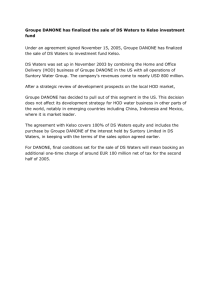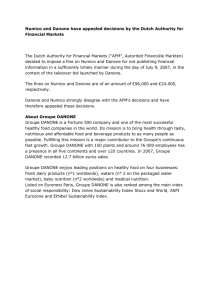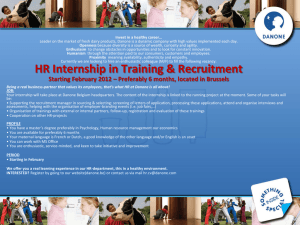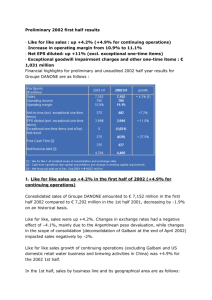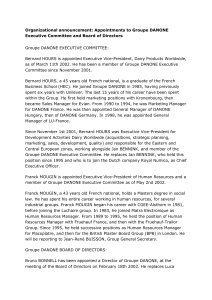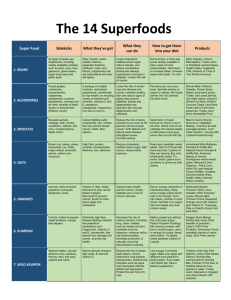Yogurt on a Mission Economic & Social Goals at Stonyfield Farm
advertisement
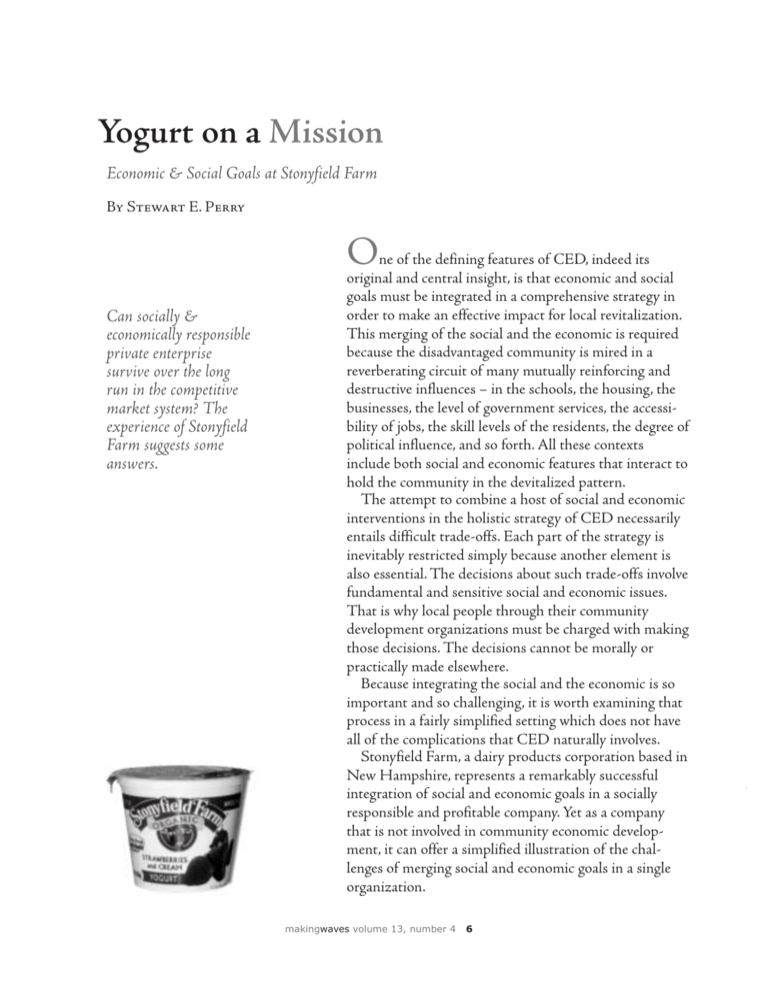
Yogurt on a Mission Economic & Social Goals at Stonyfield Farm By Stewart E. Perry O Can socially & economically responsible private enterprise survive over the long run in the competitive market system? The experience of Stonyfield Farm suggests some answers. ne of the defining features of CED, indeed its original and central insight, is that economic and social goals must be integrated in a comprehensive strategy in order to make an effective impact for local revitalization. This merging of the social and the economic is required because the disadvantaged community is mired in a reverberating circuit of many mutually reinforcing and destructive influences – in the schools, the housing, the businesses, the level of government services, the accessibility of jobs, the skill levels of the residents, the degree of political influence, and so forth. All these contexts include both social and economic features that interact to hold the community in the devitalized pattern. The attempt to combine a host of social and economic interventions in the holistic strategy of CED necessarily entails difficult trade-offs. Each part of the strategy is inevitably restricted simply because another element is also essential. The decisions about such trade-offs involve fundamental and sensitive social and economic issues. That is why local people through their community development organizations must be charged with making those decisions. The decisions cannot be morally or practically made elsewhere. Because integrating the social and the economic is so important and so challenging, it is worth examining that process in a fairly simplified setting which does not have all of the complications that CED naturally involves. Stonyfield Farm, a dairy products corporation based in New Hampshire, represents a remarkably successful integration of social and economic goals in a socially responsible and profitable company. Yet as a company that is not involved in community economic development, it can offer a simplified illustration of the challenges of merging social and economic goals in a single organization. makingwaves volume 13, number 4 6 The attempt to combine a host of social & economic interventions in the holistic strategy of CED necessarily entails difficult trade-offs.... it is worth examining that process in a fairly simplified setting which does not have all of the complications that CED involves. Stonyfield Farm has faced and continues to face trade-offs between its social and economic aims, despite the fact that both types are essential to each other and to the company’s strategy for growth and perseverance. Such conflicts are inescapable whether in a business corporation, or in a community development corporation (CDC) or any other CED organization. So we must ask, can socially and economically responsible private enterprise, including business ventures fostered by a CDC, survive over the long run in the competitive market system? Are unremitting demands for profit ever likely to bow systematically to the needs of communities, nations, and indeed the world, for the practice of human and sustainable development? This case study of a small business grown large and multinational suggests some answers to these questions. The Beginnings The natural foods dairy company known as Stonyfield Farm began in the small town of Wilton, New Hampshire. It was simply intended to generate revenue for the local Rural Education Center (REC), an organic farming school situated on a small farm run on environmentally sensitive principles. The Center was the brainchild of Samuel Kaymen, a chemical and electrical engineer who worried that the world’s food production processes were destroying the health of its inhabitants and their environment. His concern was part of a life perspective that was embodied in his engineering experience. (In the 1960s Kaymen had founded a company that built clean rooms for the aerospace industry.) The state of the environment and responsible food production eventually became even more important in the lives of Kaymen and his wife. They decided to move to rural New Hampshire to raise their own food in an environmentally respectful fashion – and raise their children on foods they themselves grew and knew to be healthful. The REC opened in 1970 and attracted students from around the world. Tuition was nominal and the program had to rely upon gifts and grants for survival. By the early 1980s it was clear to Kaymen and his board of trustees that the soft money on which the program had depended was running out, especially in view of the Reagan era cutbacks. Some other source of funding had to be found. He told his board that he knew what to do:“I’ll start a business, and the profits will support the Center.” Most were doubtful, but told him to go ahead if he wanted to. One new board member who missed this meeting was to become Kaymen’s enthusiastic partner in the business. Gary Hirshberg had learned about the REC when he had been called in to advise on the use of wind-powered water pumps at the farm. REC was an institution similar to the New Alchemy Institute on Cape Cod where he worked: a co-op devoted to educating people about the use of alternative energy forms and promoting that use. It was early 1983 when Kaymen, his wife Louise, and their six children began caring for a herd of a half-dozen Jersey cows and producing organically sound yogurt (by Kaymen’s own home recipe) in a small room off their barn. To launch the business, he had received a US$35,000 loan from the Sisters of Mercy in nearby Manchester. Sales were good, but the business was too small to make money. Production was only 50 gallons a day at the most. Within that year he was joined by Hirshberg (then 30, about 20 years Kaymen’s junior). Hirshberg made it his task to raise When Stonyfield first moved to the Londonderry site in 1990, it was one of six tenants and occupied 10,000 ft2 in the long, narrow building in the bottom left-hand of this photo. Dramatic change came in 1997-98 when Stonyfield wholly modernized its production system. By this time the facility’s sole tenant, Stonyfield added the central building to accommodate a production room, processing and packing area, and visitors’ centre. Finally, in 2000, a new refrigeration unit and warehouse (on the 2 right in this photo) necessitated an additional 15,000 ft , for the current 2 total of 120,000 ft . All photos in this article (barring that on p. 6) courtesy of Stonyfield Farm. makingwaves volume 13, number 4 7 By 1980, it was clear that the soft money on which the Rural Education Center had depended was running out. Kaymen told his board that he knew what to do: “I’ll start a business, and the profits will support the Center.” more capital. He also took on the role of CEO and helped milk the cows. Money came in, but still the business did not prosper. It needed a much bigger operation than they could manage in Wilton. By 1985, it was clear that the venture had a future, but it would require full-time attention. They closed the nonprofit REC and instead devoted the dairy business, a conventional private corporation, to the REC environmental and health concerns. Thus the aim of the business, from the beginning, was not solely to produce a profit, but also to operate in a socially responsible fashion and use profits for the social goals. At the same time, the top priority was indeed to make the business work in the marketplace. It had to be profitable in order to sustain itself and not be vulnerable the way the REC was. In their efforts to expand operations, Kaymen and Hirshberg had a couple of false starts. A partnership with a plant owner in western Massachusetts went sour and saddled Stonyfield with a $2.4 million loss. Another possible solution was to join with another dairy company that could produce at a much higher Key to Stonyfield’s success has been the way that two partners complemented one another. Says Kaymen of Hirshberg, “Oh, we had our difficulties with each other in the beginning. He was used to working in a certain way. I’m wild, spontaneous. He put it together. We were a good fit.” (below) Gary Hirshberg stands third from right. (right) Samuel Kaymen. level. A major company in Vermont seemed the perfect partner, because it also had a strong trucking system in place. But this too did not work out. At signing time, the laboriously negotiated 100-page partnership agreement had suddenly become a one-page sales agreement. The Stonyfield duo walked out of that room. So Hirshberg again set about simply raising a lot more money both for a major new facility and to pay off the debt. What they really needed was the capacity to produce nonfat yogurt, which was the key to a high sales volume in the natural foods sector. As the one responsible for the technology (and recipes), Kaymen researched the field and learned, the hard way as he discovered, how to engineer the right kind of operation. He recalls,“I really didn’t know anything. I had to learn everything. Of course, I talked to people – suppliers and such – but I didn’t have a mentor.” And for investors, Hirshberg scoured all their family and friends and people like the local dairy farmers who would have a steady market in a larger Stonyfield operation. Hirshberg’s enthusiasm and energy and the obvious abilities of both partners were enough to bring in some millions in necessary capital and a re-organization of the company. They set up their brand new operation in nearby Londonderry. Kaymen kept on learning:“I had to buy equipment and things I couldn’t even pronounce.” makingwaves volume 13, number 4 8 Business philanthropists merely offer financial support to good causes. Business social activists turn the fundamental institution of capitalist society toward social ends while still using it to perform the functions for which it is was originally designed. Success in a New Start In the new facility, sales boomed from a base of $2.5M in 1989 to $3.4M in 1990, then to $6M in 1991 (still with losses, but only modest ones), and then $10.5M with profits in 1992. With that fast start in what was, in effect, a new business in the new facility, Stonyfield has since experienced a compound annual growth rate of about 28 percent. They have expanded their sales into all 50 states and Canada and the UK and have become the fourth largest yogurt company in the U.S., with sales of $90M in 2001 and $96M in 2002. Stonyfield now has about 180 employees who produce more than 80 dairy products. For an outsider, the number of products seems incredible, but they include just about every variation on the use of milk, including varieties of squeezable yogurt for kids’ lunch boxes, ice creams, baby food yogurt, frozen yogurt, softserve frozen yogurt, etc., etc., etc. How did the company manage this success? Partly it was the growth in the natural foods sector. The U.S. market for natural yogurt grew 43 percent in 2000. Clearly a lot of people simply want products that do not contain chemicals, and Stonyfield serves that need. More generally, as Kaymen stresses, there has been a phenomenal growth in public consciousness about natural foods and the threats to the environment through poor agricultural practices and other commercial causes. All this has made a positive culture for the growth of Stonyfield yogurt. (It would not be too far a stretch to say that Stonyfield itself has been a part of the consciousness-raising process, as will be detailed presently.) Partly too the company could attribute its phenomenal growth to the way it kept ahead of the field technologically. In 1996-97, their facility underwent a process of complete rebuilding until it was state-of-the-art. A visit today to the plant reveals an intricacy of stainless steel in five assembly lines, each for a different product, varying from day to day. With workers in white coats and white hardhats, the scene is reminiscent of a sci-fi movie. Mostly, though, the success was probably the partnership of Kaymen and Hirshberg and how they were able to work together. They both were totally absorbed in learning to do everything better. Kaymen admits that he would“focus on one thing at a time. I am a bit obsessive, I guess. Maybe I’m short with people, abrupt – rude maybe.” He concedes,“I am not a professional manager. I did not know how to make people happy.” But in separate interviews they seem to vie with each other in praise and recognition of the other. Hirshberg says,“Samuel is creative. He has an astute engineering mind.” Says Kaymen of Hirshberg:“His specialty is not finance: His specialty is being a fast learner, a quick study, [for] anything. He’s an excellent manager. And he can spell ‘budget,’ while I thought that was just a government agency!” Responsibility as a Choice Alongside the financial success has been an emphasis in the company’s social and economic policy that seems actually to have been a key to the financial success. The stress is on responsibility to the planet and to the people who inhabit it, and for this the company explicitly embraces a“three-part bottom line that reflects a social, environmental, and financial mission: , To provide the very highest quality, best tasting all-natural and Certified Organic products. , To educate consumers and producers about the value of protecting the environment and of supporting family farmers and sustainable farming methods. , To serve as a model that environmentally and socially responsible business can also be profitable. , To provide a healthful, productive and enjoyable work place for all employees, with opportunities to gain new skills and advance personal career goals. , To recognize our obligations to stockholders and lenders by providing an excellent return on their investment.” “We have been on a 50-year drunken binge with chemicals,” says Hirshberg. He & Kaymen are adamant about the importance of natural foods & the responsibility of corporations to improve the public’s eating habits: “It’s not enough to advocate; you have to be an example, a model.” makingwaves volume 13, number 4 9 Mission statements have a way of meaning different things to different people. But the two founders agree on the underlying meaning. Kaymen is quite explicit:“If things are going to be changed, corporations will have to take responsible action and think like human beings.” For Hirshberg:“We are in business to change the world.” He says,“The reality is that we are a ‘transitional company’,” meaning that Stonyfield is pointing the way to new practices that must be adopted for a new age, especially for food production. And in order to do this, a business must demonstrate that it is financially successful not just by good management of money but by being socially responsible.“It’s not enough to advocate; you have to be an example, a model,” according to Hirshberg. Fundamental to the company, of course, is its commitment to organic or natural foods, not because the founders discovered a consumer demand for them but because of a dedication to what the founders believe is a healthy perspective on food. They believe that good food must not be chemically engineered, even if the plant that produces the food is a state-of-the-art engineering feat. Thus, absolutely all of the milk used in Stonyfield products is bought from dairy farmers who will not use the synthetic growth hormone (rBGH) on their cows to raise their milk production. And no other chemicals are ever used. Moreover, more than 1300 acres of farmland receive financial support from the company to forsake the use of pesticides. Insisting on no rBGH and on no pesticides means that their costs for raw materials today are higher than their competitors’, and their margins are necessarily lower. That is one significant trade-off.“However,” Hirshberg exults,“our hypothesis is now a finding: The company mission generates what all companies consider to be the Holy Grail in consumer products – that’s (above) For many years Stonyfield never advertised. Existing demand kept it plenty busy, and no agency could satisfy Kaymen that he would get measurable returns from the money spent. Regular advertising, which stresses Stonyfield’s social mission and often comes dosed with humor, began only after Kaymen left the board. A good example of this is Stonyfield’s “Lid Program” that informs consumers about health and environmental issues and the activities of many nonprofit groups. (Significantly, the Lid Program is now on hold, because Stonyfield has switched from plastic to the more environmentally-sound foil lid.) customer loyalty. The good news is that the things we care about [the environment, natural foods] create loyalty. So our selling costs are lower.” When a consumer chooses Stonyfield with social causes in mind, the chances are very good that they will not have to be sold again on the high quality product they have bought; and they will be interested in other Stonyfield products. In any store, Hirshberg surmises, when some other yogurt brand is not available, the buyers just take whatever else is there.“But when we are off the shelf, people scream.” That is why, he believes, Stonyfield yogurt is gaining in the ordinary supermarkets and also is number one in the $100M market in natural foods stores, where they have 38 percent, more than the next six brands all together. For Stonyfield the three bottom lines merge. Ecstatic letters from consumers plaster a wall in the Visitors’ Center; they praise both the products and the company’s policies. The company underlines its persona by the motto,“Yogurt on a Mission.” The Policies Ruling out chemicals is a key policy, as has been suggested. The founders would like to go further than that. They would prefer to deal only in organic certified products. Although some of their products are certified, some are not because that would out-price them too far in comparison to competing non-certified brands. This is another difficult trade-off for the food-sensitive founders of the company. At any rate, all Stonyfield products use the same hormone-free milk, a fact that can be advertised on the products although it took a court case to determine that such a label was legal. No other extraneous chemicals are ever used. Currently about 70 percent of its production is organic – a major accomplishment, considering that seven years ago they had not entered the organic products market. Concern for the environment means that the company puts great stress on its own environmentally relevant activities, using a well-known adage,“Recycle. Re-use. Reduce.” Approximately 71% of its own waste stream is recycled. All corrugated paper is sold, as is all plastic. Some wastes are given away; the organic wastes are given to local pig farmers, and the white buckets that are not sold are given away too. Even the waste heat is recaptured to heat makingwaves volume 13, number 4 10 There has been a phenomenal growth in public consciousness about natural foods & the threats to the environment through poor agricultural practices & other commercial causes. All this has made a positive culture for the growth of Stonyfield yogurt. water for the plant, annually saving thousands of gallons of propane gas. Similarly, the plant itself and its operations have been designed on environmental principles. It was built of recycled materials, and it boasts high energy-efficient electric motors and low-wateruse flush toilets. The use of skylights reduces the amount of electricity needed. Educational programs for employees ask for suggestions for further environmental improvements. The total job of one staff member, reporting directly to Hirshberg as CEO, is concerned with environmental issues. It would be no surprise, then, that the company has won many awards for environmental practices by businesses. The plaques and certificates are on display at the Visitors’ Center, from which tours are provided for thousands of adults and children each year. Insofar as employee relations are concerned, Kaymen points out that the company operates in the usual hierarchical fashion, “but we trust people as human beings.” Suggestions are welcomed and freely made. Employees are given four days paid time off to donate their efforts to nonprofit organizations of their choice. Stonyfield also has offered stock ownership opportunities (employees now own about 25 percent of the company), and Hirshberg stresses that it is his own philosophy that workers need to have not only figurative but literal ownership in the company. He has matched his philosophy with personal gifts of stock to long-term employees, and he serves on the board of a small Vermont flour company that recently became totally employee-owned. With such convictions it is not surprising that the company devotes a substantial fraction of its advertising budget to public information causes, especially about healthy food. The labels on the lids of the yogurt products rotate messages, one-third of the lids comment on what is good for the consumer’s health (such as alerting the consumer to the body’s need for calcium), one-third on what is good for the planet (mostly regarding environmental issues but also energy and transportation), and one-third on what is good for the brand name (e.g., advertising related products). In addition, ten percent of pre-tax profits go to nonprofit organizations active in environmental issues, in health issues, and for other significant social causes, such as handgun control, increased use of public transit, even efforts to assure the proper tire pressure for your automobile. To Sell The Company? With such success and good prospects for the future as the turn of the century loomed, it would seem as if the company needed no more than to keep up with demand for its products. However, by the late ’90s some of Stonyfield’s 290+ shareholders (one-third of them employees) had been with the company for as much as 15 years, others for 10 or 12. Some really needed to exit their investment and get the rewards for sticking by the company all that time. It was time for them to realize some return on their investment. Some were local small dairy farmers who were at or near retirement, and the proceeds from the sale of the privately held company would make a lot of difference in their retirement plans. (Even Kaymen, nearing 65, was thinking about retiring.) So here was to come another set of trade-offs, perhaps the most fundamental of all. One solution would be to go public. Ben Cohen and Jerry Greenfield (friends of Kaymen and Hirshberg) did that with Ben and Jerry’s Homemade, the very successful and socially responsible ice cream firm. But their experience was not encouraging. In the end, the stock had been bought up by Unilever, a British multinational that downgraded the social goals of the ice cream company. To try a different tack, Hirshberg asked Lazard, an investment banking firm, to find a special partner with deep pockets. Lazard came up with a potential corporate buyer that asserted it was ready to respect Stonyfield’s tradition. This was Groupe Danone, a France-based multinational with its own top American yogurt product, Dannon. Groupe Danone was excited about the prospect of entering the U.S. natural food marketplace through Stonyfield’s products, a niche they did not see entering on their own. They offered to buy most of the company at a very attractive price. But Hirshberg was having none of that. He would be willing to let them buy a minority ownership (essentially buying out most of the shareholders, but leaving him and the worker-owners still in control). As it was, he was worried that the huge multinational corporation would have undue influence on the flexible and swift decision-making that he was used to as chief executive officer.“There’s not a lot of distance between this company and me,” he once commented.“It’s like selling your own child.” makingwaves volume 13, number 4 11 The deal was conceivable only because Groupe Danone recognized that Stonyfield occupied a different & special niche. The company was successful partly as a lifestyle & cultural phenomenon, not a simple matter of markets & sales. But Groupe Danone insisted it was still interested. It would be flexible; it would take a minority position for now and really respect Stonyfield’s way, show how it could work in that tradition. As Kaymen said later,“They understand and value our way and who we are.” Groupe Danone wanted eventually to have a majority interest, but that could be, say, two years along the way. The negotiations went on. As many as 30 issues had to be worked out in tedious detail. Every so often, doubts overcame Hirshberg, and his single-minded concerns began to make Groupe Danone impatient. To Hirshberg the deal just didn’t seem worthwhile at times. He recognized his responsibilities to his shareholders, but when it came right down to it, he wanted to continue to run the company his way. His way was successful. A bureaucratic corporation like Groupe Danone (with some 84,000 employees) was not likely to have the same nimble capacity that Stonyfield had thrived on. Groupe Danone sold more than $12B worldwide annually, Stonyfield less than $100M. Danon was number one in the world for volume of yogurt sold and number one in bottled water (Evian is its leading product). The scale of the two parties was simply not the same. For almost two years the negotiations struggled on. Hirshberg got Groupe Danone to agree that any ownership over and above their proposed initial minority position would be tied to certain benefits to accrue to Stonyfield – e.g., cost savings through combined buying for the plastic cups. Further, if Hirshberg were to ask for a corporate decision on something (for example, on financing a new production facility in the western part of the U.S.), Groupe Danone would accept a timeline for getting back to him with a final answer. That would reassure Stonyfield that decisions would not be caught up in a cumbersome bureaucracy. So every so often, things would look fine for signing a partnership agreement. But then something else always seemed to hang everything up. Finally, in October 2001, Hirshberg met with representatives of Groupe Danone for the last act of the process. Right down to the last moment he had his doubts:“If I had been able, I wouldn’t have done it.” As it was, the paperwork took one hour, but Hirshberg signed. Groupe Danone immediately got to purchase 40 percent of the shares and to choose two members of the board of Stonyfield. (Kaymen, now 67, planned to retire, and one other member also agreed to resign.) The price was said to be about $100M, but Hirshberg will only say that it was more than that. So the smaller stockholders realized a handsome return for their confidence in Stonyfield. The European company had the right to purchase a majority share after two years. This essentially would buy out all owners who are not employed by the company, leaving employee owners (including Hirshberg) with their current stock holdings. (Employees could sell, but did not have to, and Hirshberg urged them to hold on.) By 2016 Groupe Danone could buy all of the stock. But even here Groupe Danone made an incredible concession: They agreed to leave Hirshberg with general control (through a majority of the board – three of five members) even after Groupe Danone has majority ownership. He would be the CEO for a minimum of four years, up to fourteen, and even after that he could stay on indefinitely, if he wanted to, not subject to being fired except for criminal behaviour and the like. And during that period Groupe Danone would not buy all the rest of the stock. This deal was conceivable only because Groupe Danone recognized that Stonyfield occupied a different and special niche. The company was successful partly as a lifestyle and cultural phenomenon, not a simple matter of markets and sales. Hirshberg feels that they showed“unusual courage, foresight, and imagination” to accept such a deal. He notes that in his search for a partnership, he found European companies more open, at least, to the possibility of ceding control than any American companies. Of course, the deal required that certain profit targets would be met, but given those, they agreed that for at least the next ten years ten percent of profits would continue to go to the same sorts of nonprofit organizations as before. Groupe Danone has its own environmental record, especially with regard to packaging, of which it is proud. Hirshberg believes in Groupe Danone’s corporate position, saying that they are“one of my leading role models in terms of large corporate responsibility.” Even while negotiations were in process, Groupe Danone was involved in a controversy concerning the closure of a biscuit factory in France. Hirshberg made it his business immediately to investigate the matter. He concluded that Groupe Danone’s accommodation of the workers was“fantastic.” Although some workers were protesting, no one actually needed to lose a job, and those taking severance got more than U.S. standards would have provided. makingwaves volume 13, number 4 12 Could something happen to disrupt Hirshberg’s deal? Right during negotiations Stonyfield experienced a crisis of a sort that could conceivably activate the provision by which Groupe Danone could assume control if the company was endangered. Here is what transpired. The U.S. Center for Science and Public Policy, in a report on Federal Drug Administration enforcement of labeling rules, noted that one brand of Stonyfield yogurt depicted a strawberry on its label, but contained no strawberries at all. Stonyfield was outraged. The label stated clearly that it was (naturally) strawberry flavoured and, like most flavoured food products, did not contain the fruit. Any fruit used in such a product would make no difference to its nutritional value. Just the same, the publicity was unsettling and Hirshberg complained to the Center director, whom he knew well. It was a worrisome experience. (Stonyfield changed its yogurt formulas so that each brand would include trace amounts of the fruit juice or fruit concentrate – satisfying the labeling rules without making a bit of difference to the yogurt’s food value.) With such unexpected events, how the partnership will work out will be a matter for experience to tell. For example, who is to say that Hirshberg will stay on? Stonyfield is not his only idea for a socially responsible business. In 2001 he co-founded a new venture to build a chain of natural fast food restaurants. One is already in operation and five or six scheduled to open soon. The name: O’Natural. As Hirshberg says,“While I don’t intend to leave [Stonyfield], who knows?” What do the founders think is the upshot of this new phase in the story of Stonyfield? For other businesses that have social goals but need to find a major partner, Hirshberg believes that Stonyfield has again offered a model. He said,“I believe we may not have the ultimate solution for everyone, but we’ve made it clear to our fellow entrepreneurs that such a solution is possible.” Kaymen commends his partner for creating the legal conditions under which Stonyfield is still Stonyfield. He says,“The sale contract with Groupe Danone pins down everything to be continued in the same way for [our aims of ] corporate responsibility.” Implications For CED There is quite a difference between business philanthropists and business social activists. So says Jack Quarter in his book Beyond the Bottom Line. The former merely offer financial support to good causes. The latter turn the fundamental institution of capitalist society toward social ends while still using it to perform the functions for which it is was originally designed: the generation of revenues and profits for the owners through the provision of the services or goods in demand. Some business social activists use the business to deal with the basic inequity that the capitalist system engenders – the use of the workers’ energies and ideas for the capital owners’ benefit. These businesspeople seek ways in which the workers can participate more fully in the benefits that their efforts produce, including ways to participate in ownership. Other social activist business owners direct the business to address social injustices that may be the general result of business operations (like environmental degradation) or that may arise Yogurt production, Then and Now. (above left) The 2-head rotary yogurt filler used at the Wilton farm in the ’80s filled 3000 cups per hour. Stonyfield currently maintains five machines that each process 30,000 cups per hour. (middle) In 1994, Stonyfield was still making its yogurt in batches. Employees poured flavouring into a tank of yogurt, which was then emptied into cups and cleaned to receive a new batch. Rising demand outstripped this approach completely. Stonyfield overhauled its plant in 1997-98 to commence continuous processing and to segregate the packaging system (in the foreground of the right-hand photo) from the filling equipment. This massive investment testified to the owners’ and investors’ belief in the brand long before the deal with Danone. makingwaves volume 13, number 4 13 The conflicts & trade-offs between the social justice aims and the economic viability of business enterprises of any sort are an excruciating part of CED. So it is that most attempts to merge social & economic goals (especially when the goals are ambitious) will be problematical. outside the realm of business itself (e.g., cultural patterns like gender discrimination). What the founders of Stonyfield accomplished represents an effort to address both sorts of issues. For example, they offered opportunities to employees to become stockholders in the company and protected that interest when the company was sold to Groupe Danone. They also directed company operations and resources toward social issues outside the company – environmental protection for the planet and the health of its inhabitants. It is safe to conclude that health and environment were addressed not for extraneous reasons but because such values were an integral part of the founders’ lives. The first category of justice issues – that of worker participation in the benefits of the business as an institution – appears to be of integral importance to Stonyfield, even though employees (apart from managers) have not had a major opportunity to participate in the business’ actual governance. This, according to Quarter, is common in the socially innovative business. The original owners, who exert managerial control to turn the business to social ends, are usually quite loath to share that control. The same reluctance can be observed in CED business strategies. That is, those who execute the strategy (boards and top staff ) have a hard time entrusting to all workers a decisionmaking role in the CDC and its ventures. Despite this reluctance, local empowerment remains a key element in successful CED. The capacity of residents to assess and direct their own destiny in concert with others is a critical measure of CED accomplishment. Empowerment of local residents may begin with determining the goals and processes of the CED organization itself; but it certainly must move on into other arenas if the community is to improve substantially. And so a CDC may foster local empowerment in other contexts – for example, foster businesses in the co-operative format. Usually, however, within the businesses that are owned in part or in whole by the CDC – or fostered by it – the participation of the workers in guidance and in governance is infrequent or no more developed than at Stonyfield. This suggests that the business institution itself (and its market context) has features that handicap efforts to make it an integral part of a strategy of empowerment with mutually reinforcing social and economic goals. Moreover, those businesses that do have a governance structure in which worker participation is real may face significant disadvantages when operating in a competitive quasi-free market system. The conflicts and trade-offs between the social justice aims and the economic viability of business enterprises of any sort are an excruciating part of CED. So it is that most attempts to merge social and economic goals (especially when the goals are ambitious) will be problematical. It is one of the inescapable challenges of CED. Only by confronting them (as much as we, rather naturally, would often prefer to avoid them) will practitioners find the creativity to make CED a formidable and permanent fixture in today’s global economy. We can take heart that the culture of business is itself in flux, and the concept of corporate social responsibility – so admirably illustrated in Stonyfield – can be a part of an emerging new order in the social economy of the world. An important aspect of this new order is the Global Compact on Corporate Social Responsibility (for environmental, labour, and human rights). That compact exemplifies a central technique of CED – namely, enlisting multiple stakeholders instead of relying upon governments to come up with solutions. The Global Compact was not a product of the world’s governments in the UN General Assembly or Security Council, although it was fostered by UN Secretary General Kofi Annan. The compact has recruited about 400 signatories worldwide, including international organizations representing labour. Without attempting to establish legal and sanctionable responsibilities for observing environmental, human, and labour rights, the compact asks the corporate signators to seek out partnerships with third-world countries to promote those rights and the associated good practices which otherwise are chancy in such countries. The corporations may also commit to participate in a kind of ongoing seminar in which they present a problematic experience of an issue in relation to one or more of those three topics (such as trying to maintain responsible operations while a civil war is in process in the host country). Another so-called learning forum is designed to surface a group of good practices, as presented by the corporations, which can be adopted by other companies and governments. There is a strong contingent of corporations based in Europe, where the political and social pressures represented by the Green parties have already changed corporate behaviour to some extent. Groupe Danone is not, at this writing, a signator. makingwaves volume 13, number 4 14 Only by confronting the challenges (as much as we, rather naturally, would often prefer to avoid them) will practitioners find the creativity to make CED a formidable & permanent fixture in today’s global economy. But Hirshberg will pursue that. He may have a better chance of success than if his partner were an American company. Multinationals in the U.S. have been less than enthusiastic, with only eight or so signed up. Among these are corporations like Nike and Shell, which have learned the hard way that corporate responsibility is necessary to the bottom line. In Canada, CED practitioners are heartened by the beginnings of systematic corporate collaboration in a more socially oriented perspective for economic development in Québec. If it can happen in Québec, if it can happen at Stonyfield, if it can take root in hundreds of corporations around the world and be exemplified in the work of CDCs in North America, then perhaps that central insight of CED – that social and economic goals must be integrated – will indeed engender a better future for the disadvantaged of this world. References Cheney, George. Values at Work: Employee Participation Meets Market Pressure at Mondragon. Ithaca and London: Cornell University Press, 1999. Neamtan, Nancy.“Full Partners,” Making Waves 12,2 (Summer 2001) 35-40. Perry, Stewart E. Collecting Garbage: Dirty Work, Clean Jobs, Proud People. New Brunswick, NJ: Transaction, 1998. Quarter, Jack. Beyond the Bottom Line: Socially Innovative Business Owners. Westport CT: Quorum Books, 2000. Rose, Julie.“Selling His Soul to Dannon?” Fortune Small Business (December 2001January 2002) 39-42. Russell, Raymond. Sharing Ownership in the Workplace. Albany, NY: SUNY Press, 1985. STEWART E. PERRY, an associate of the Centre for Community Enterprise and member of the Canadian CED Network, has been active in CED for over 35 years. This article stems from a case study he prepared for a conference at Southern New Hampshire University in May 2003. He has also recently taken to organic yogurt. (Samuel Kaymen admonished Stewart for not recognizing the name of a local natural food store: “If you don’t know that store, I know you are not eating right!”) Contact him at stewartp@igc.org. Specializing in Revitalizing Resource-Based Communities through Renovation & Marketing Surplus Housing «Gold River, BC (145 homes sold) Select Property Group assists the revitalization of resource-based and decommissioned «Masset, BC military base communities through the (190 homes sold) successful renovation and marketing of their «Plattsburgh, NY surplus residential property. Select Property (224 homes sold) Group offers specialized marketing that «Manitouwadge, ON will bring new families into communities, (150 homes to be sold) who will q q q q q «Cornwallis, NS purchase and occupy the homes (255 homes sold) become involved in the community «Logan Lake, BC patronize local businesses (200 condominiums sold) pay taxes «Tumbler Ridge, BC (1000 homes & condominiums sold) and who will possibly start new local ventures Contact us for our Corporate Video or DVD and other information: Select Property Group 1130 Pender St. West, Suite 545 Vancouver, B.C. V6E 4A4 Website www.selectpropertygroup.com Office: (604) 669-5822 e-mail: rgalbrai@direct.ca makingwaves volume 13, number 4 15
